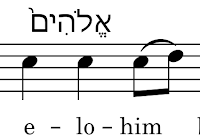Now it's time to deal with each of the te'amim and see their xml output. We have seen 4 examples in the first post here.
The silluq translates to this (All the Unicode is here.) The silluq is the pattern for all the changes in reciting note.
<note>
<pitch>
<step>E</step>
<octave>4</octave>
</pitch>
<duration>6</duration>
<voice>1</voice>
<type>quarter</type>
<lyric number="1">
<syllabic>[begin|middle|end]</syllabic>
<text>[syllable of text here]</text>
</lyric>
</note>
| The Accents of the Hebrew Bible relating to the Music | |||
| Below the text | |||
| Recitation | Accent name | XML output where different from above | |
| c |
֧ |
darga |
<step>C</step><octave>4</octave>
|
| d |
֢ ֛ |
galgal (prose), tevir (poetry) |
<step>D</step><octave>4</octave>
|
| e |
ֽ |
silluq | see above for the pattern for all signs below the text |
| f |
֥ |
merkha |
<step>F</step><octave>4</octave>
|
| g |
֭ |
tifha, (d’khi) |
<step>G</step><octave>4</octave>
|
| A |
֑ |
atnah |
<step>A</step><octave>5</octave>
|
| B |
֣ |
munah |
<step>E</step><octave>5</octave>
|
| C |
֚ |
mahpakh, (yetiv) |
<step>C</step><octave>5</octave>
|
| dm |
֦ |
double merkha, kefulah | == merkha above |
|
֙ |
<note><pitch><step>[reciting note]</step> <octave>[reciting note]</octave></pitch> <duration>3</duration> <voice>1</voice> <type>eighth</type> <notations><slur type="start" number="1"/></notations> <lyric number="1"><syllabic>[begin|middle|end]</syllabic> <text>him</text></lyric> </note> <note><pitch><step>[reciting note + 1]</step> <octave>[of reciting note + 1]</octave></pitch> <duration>3</duration> <voice>1</voice> <type>eighth</type> <notations><slur type="stop" number="1"/></notations> </note> |
||

No comments:
Post a Comment